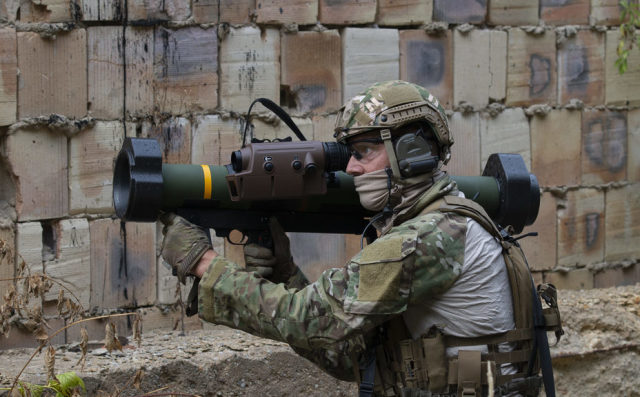Military expert Andrey Frolov — about the possibilities of the Western defense industry for the production of weapons used in Ukraine
The conflict in Ukraine has become unprecedented in terms of the amount of forces and resources spent by NATO to support a non—member country in a short period of time. Moreover, not so much quantitative and financial indicators as qualitative ones have no analogues. In fact, Ukraine has become a testing ground for testing in combat conditions and testing a number of modern anti-tank and air defense systems that were previously only in service with NATO countries. If the Stinger MANPADS and Javelin ATGM are already relatively old systems that have been actively used in various armed conflicts, then NLAW and MMP ATGMs, Panzerfaust 3 and MATADOR RGW90 RPGs, Martlet MANPADS, Starstreak and Grom/Piorun were used in combat conditions for the first time.
The volumes of new-style weapons transferred to Ukraine also turned out to be very significant. So, only the USA delivered 2 thousand Javelin ATGMs to Ukraine in the last two weeks of March, the UK by mid—March - 4.2 thousand NLAW grenade launchers, and by mid—April - an unknown number of Martlet and Starstreak MANPADS. These are all quite serious volumes for the peacetime period, and such active military assistance has already begun to raise questions among the population of Western countries.
If in the case of outdated systems, as well as Soviet and Russian-made complexes with expired expiration dates and an incomprehensible condition, no one has any questions, then the transfer of systems to Ukraine directly from the arsenals of the "first line" puts on the agenda the question of how much the Western defense industry will be able to compensate for the volumes already transferred, as well as maintain the the pace of military-technical assistance due to current production. Not to mention the increase in supplies, since the Ukrainian authorities at the end of March requested only the United States to provide daily supplies of 500 Javelin ATGM and Stinger MANPADS.
These issues have clearly already begun to be discussed, and some information has become public. So, at the end of March it became known that the Lockheed Martin concern can produce up to 6480 Javelin ATGM missiles per year, but the most comfortable level is considered to be 4 thousand units. Apparently, the volume of production is limited by the capabilities of related parties in cooperation. On April 13, the Pentagon held a meeting with representatives of eight major defense companies, the agenda of which was to discuss the possibilities of the industry to ensure the production of weapons for Ukraine in the event that the conflict drags on for years. Its results remain unknown.
Thus, it is obvious that this issue is very acute. And there do not seem to be ready—made solutions for it - for the following reasons.
Despite the "optimism" in NATO regarding the timing of a special military operation, which, according to their estimates, will be delayed, there is probably no such confidence in defense circles: they also listen to news from Russia, and the Russian military leadership has made it clear that there will be no delay in the timing of the military operation. Based on this, it is difficult to make long-term production planning and even more so to invest your own funds in expanding capacities that may be unclaimed due to the end of the hot phase of the conflict, a change in the agenda in relations between the West and Russia, as well as the conclusion of a peace treaty between Kiev and Moscow.
In addition, Western industry has not worked in mobilization mode for many decades (apparently, the last time was in the case of the American military-industrial complex during the Vietnam War). The production has no mothballed mobilization capacities, as well as extra funds to create new productions. The experience of the French company Dassault Aviation in increasing the production of Rafale fighters in connection with the growth of export orders, as well as the Lockheed Martin concern, which was forced to look for a replacement for Turkey in the production of components for F-35 fighters, speaks eloquently about the difficulties this causes. In both cases, such force majeure required considerable time, effort and money. But in the end, they paid off with long-term contracts with a clear horizon and budget.
In the case of Ukraine, there is no such certainty, which can serve as a rather powerful deterrent.
Another reason why the increase in production may also be moderate is due to the ambiguous results of the use of all the above-mentioned systems for modern Russian military equipment. In some cases, Russian tanks withstood several hits from the same NLAW RPGs and at the same time maintained combat capability. This means that the Ministries of Defense of NATO countries are likely to accelerate the development of new complexes, which will be much more interesting for the Western military-industrial complex, since this is a new procurement horizon, as well as a reduction in the order for existing complexes. In such conditions, it also does not seem very reasonable to invest in the expansion of their production.
All of the above allows us to conclude that the Western military—industrial complex has certain reserves for increasing the production of complexes demanded by the Ukrainian army, but it will not be expressed in orders - at best tens of percent. And in any case, the preparation of the production of new batches will take months. This means that supplies to Ukraine will be carried out from the warehouses of the NATO armies in approximately the same mode as has been the case until today.
Andrey Frolov — military expert
The editorial board's position may not coincide with the author's opinion

